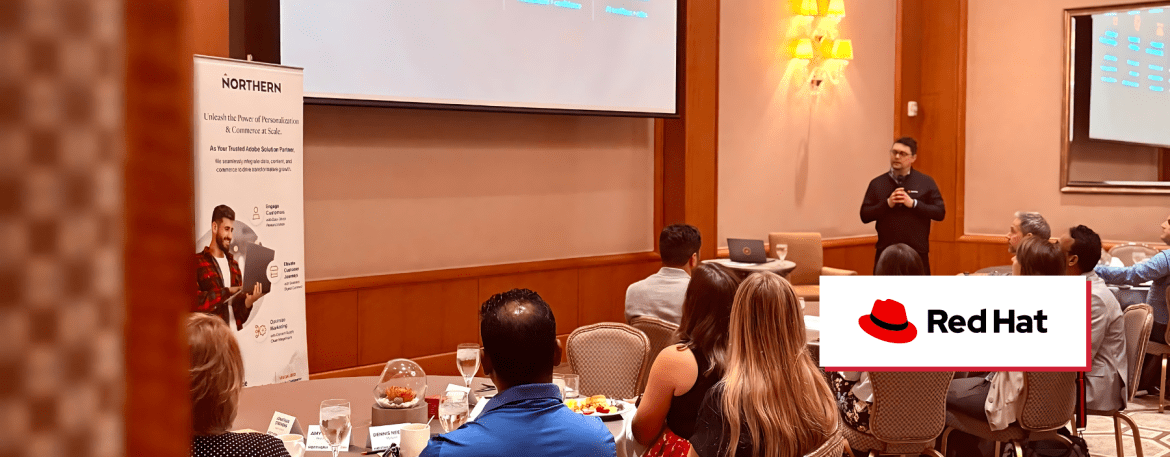Taming Fragmentation: How Red Hat Is Building a Unified Digital Experience Ready for an AI-Driven Future

Recently, in partnership with Adobe, we had the pleasure of hosting enterprise CX leaders from the Raleigh, NC area for one of our CX Café events. This event series facilitates strategic conversations on leveraging personalization and content in the age of AI, a crucial topic given the rapid pace of innovation from CX technology partners like Adobe.
A highlight of the session was our guest brand showcase featuring Rob Chappell , Sr. Director of Digital UX at Red Hat. Rob shared a compelling look into Red Hat's focus on unifying a complex digital ecosystem to create a human-first experience ready for an AI-driven world.
The discussion was so rich with actionable insights that we wanted to continue the conversation. In this follow-up Q&A, we dive deeper with Rob on the core principles, strategic frameworks, and design leadership required to build a truly connected digital experience.
Q&A with Rob Chappell
Northern: Red Hat is known for its powerful open culture and innovation. How has that shaped your digital landscape and approach to user experience design?
Rob Chappell: Red Hat’s open culture has helped fuel its immense growth. But naturally, as the company has grown, it has also led to a complex and diverse digital approach. Multiple platforms with inconsistent content and UX strategies create a customer journey that lacks the cohesion today’s users expect. Customer experience needs to be as frictionless as possible, so in recent years we’ve focused on addressing digital fragmentation by unifying Red Hat’s digital channel through shared systems and standards…and maybe most importantly, shared collaboration frameworks.
Northern: What was the core philosophy that guided your UX team’s approach to this transformation?
Rob Chappell: Our approach is guided by core principles that we established for our Digital UX team. It all starts with being co-creative. We firmly believe that UX design is a team sport, involving feedback from many contributors both inside and outside of Red Hat. Tech investments only take you halfway; the real magic happens when you align cross-functional teams—marketing, design, engineering, product management and ops—around a single, shared vision of the customer experience.
Of course, all of that collaboration must be user-centered. Our primary focus is always on the people we are designing for. We advocate for their success at every step of the process. To do that effectively, we have to be holistic in our thinking. We consider the entire end-to-end experience, not just a single moment, website, or journey stage. This ensures we are creating a seamless journey rather than a series of disconnected touchpoints. We’ve built connected experience frameworks to map ideal user journeys and use UX scorecards to create shared accountability and ensure we were all moving in the same direction.
To deliver that holistic vision at scale, our work must be orchestrated. This means ensuring our processes, tools, and roles are aligned to deliver and maintain an optimal Red Hat digital experience. Together, these principles provide both the 'why' and the 'how' behind our transformation.
Northern: You've mentioned building 'connected experiences.' Can you expand on what that means at Red Hat and how that framework guides your team's approach to design?
Rob Chappell: Building a shared user journey framework and toolkit was a project several years ago driven by our Design Program Office to help teams across Red Hat align on unified digital strategies and end-to-end user journey success. Dubbed “Connected Experiences” – the framework has been a foundational collaboration tool, helping teams across the organization use the same journey stage definitions and common user flow templates. At its core, it's our response to a fundamental truth: users expect digital engagements that respond to who they are and what they need in the moment. A series of disconnected touchpoints, no matter how well-designed individually, just doesn't meet that expectation. It helps our teams map out how all the small pieces and individual touchpoints fit together into a cohesive, end-to-end journey.
Northern: Looking ahead, user expectations are clearly shifting toward AI-powered interactions. How is your team leading the charge to meet this moment?
Rob Chappell: We’re seeing a clear demand for AI to play a role in digital interactions. Our user research studies and insights convey that users want faster answers and smarter, personalized content. We're evolving our internal structure by creating an AI acceleration team and making applied AI a top priority. This is a proactive embrace of AI tools and workflows, not just as an experiment, but as a new way to elevate the experiences we craft. We are already finding value in the daily, practical use of AI tools for UX and are fostering a culture of open sharing and learning around our experiments. We see AI as an augmenter for our team, not a replacement for the empathy, user understanding, and strategic thinking that are more critical than ever. Our focus remains squarely on user needs and brand consistency as we guide how these new AI-assisted experiences are delivered to Red Hat users.
Northern: For other design and marketing leaders embarking on a similar journey, what key insights would you offer?
Rob Chappell: It's an exciting time to be in this field. The opportunity with applied AI raises the stakes for the foundational work of aligning a global enterprise to unified experience delivery. A few lessons really stand out to me:
- A single tool won’t unify your digital experience—systems thinking will. You have to think in layers: user journeys, standards, platforms, workflows, people, and performance. Orchestration focus is where the real transformation happens.
- Alignment work is strategic work. Shared frameworks are what create true cohesion. Your company cohesion is your velocity, investing in it is how you move faster.
- AI readiness starts with people. Before you can scale AI, you have to prepare your teams. It's about demystifying the technology and getting people comfortable and fluent with this new way of working. Create the space for it to happen. The roles and the skills you cultivate need to evolve for what's next.
Closing Thoughts
Unifying complex ecosystems takes more than platforms. It requires shared vision, co-creative ways of working, and disciplined orchestration. With AI raising the bar on speed and relevance, the organizations that align people, process, and platforms around connected journeys will win on experience quality and delivery velocity.
Keep the conversation going at CX Café
Join our invite-only breakfast series with Adobe and enterprise CX leaders.
Want help mapping connected journeys or preparing your digital experience for AI? Get in touch with Northern.
Stay informed, sign up for our newsletter.

